Suicide, defined as the intentional ending of one's own life (1), is a significant global public health issue that affects individuals across the lifespan and in diverse populations (2). According to recent estimates from the World Health Organization (WHO), more than 720,000 people die due to suicide every year. This makes suicide a significant global health issue and the third leading cause of death among individuals aged 15–29 years (3). The global average crude death rate is 9.2 per 100,000 population. Europe was the highest with a rate of 12.8 per 100,000 population, followed by Southeast Asia and the Americas (4). In addition, rates among men aged 45–64 years have increased from 21 suicides per 100,000 in 1999 to 30 per 100,000 in 2017 (5). Suicide has posed a serious challenge to the world, especially in low- and middle-income countries (6), where nearly 77% of suicide deaths occur (3).
Self-harm is often used to describe a broad spectrum of behaviors and intentions, including attempted hanging, impulsive self-poisoning, and superficial cutting, typically as a response to intolerable tension (7). Self-harm serves as a significant predictor of suicide (8–10). The risk is highest in the first 6 months following a self-harming episode but persists for several decades (10). Male gender, advanced age, and multiple instances of self-harm have been identified as predictors of subsequent suicide (9). Similar to suicide, self-harm rates fluctuate significantly among countries. In 2004, 5–9% of adolescents in Western countries reported having self-harmed (7). This illustrates the importance of analyzing the epidemiology of suicide and self-harm, as well as the related characteristics (11) to achieve the sustainable development goal of a one-third reduction in the global suicide rate by 2030 (12).
In China, alongside rapid economic development and changes in social structures, the rates of suicide and self-harm have significantly decreased among men and women, urban and rural residents, and across all age groups (13–15) over the past 20 years (15, 16). The WHO report estimated that the suicide rate in China decreased by 59.6%, from a standardized age-adjusted rate of 19.4 per 100,000 population in 2000 to 7.8 per 100,000 in 2012 (13). Globally, the overall incidence, mortality, and Disability-Adjusted Life Year (DALY) rates for self-harm showed a decreasing trend from 1999 to 2019, with estimated annual percentage changes (EAPC) of −1.5351, −2.0205, and −2.0605, respectively. This trend may also serve as evidence of a decline in self-harm rates in China (17). Explanations for this variation include differences in how suicide cases are classified, cultural attitudes toward suicide, access to lethal means, and the adequacy of treatment for mental disorders (5). Notably, although various Chinese provinces generally share a similar cultural background, the levels of their economic development and urbanization—factors closely related to suicide rates—vary significantly (18). Therefore, in order to precisely understand the trends of suicide and self-harm in China, studies that focus on representative regions and utilize high-quality medical registration data are indispensable (3).
Suicide and self-harm behaviors are multifactorial, involving complex interactions between biological and environmental determinants (19). In high-income countries, mental illnesses are estimated to be present in half of those who have died by suicide, with affective disorders (depression and bipolar disorder) accounting for one-third to half of all suicides (20). Studies of self-harmers presenting to hospitals using standard diagnostic criteria have shown that over 90% have at least one psychiatric disorder, most commonly depression, followed by substance abuse and anxiety disorders (21, 22). In China, ~30% of individuals who die by suicide have mental disorders, such as depression (23). Given the high prevalence and serious consequences of self-harm, it is also critical to further understand its risk and protective factors (24). Previous study has found that suicide rates are higher among older rural women, with pesticide ingestion being the most common method of suicide in China (25). Since the 1990s, restrictions on access to highly hazardous pesticides have contributed to a reduction in suicide deaths in China (26). In fact, the focus should shift to consider the driving forces behind suicide, particularly common risk factors such as socioeconomic disadvantage, low social support, increased burden, and unemployment, which have been increasingly associated with suicidal behaviors in recent years (27–29). Additionally, the epidemic of communicable diseases, such as COVID-19, can serve as a significant life stressor for individuals and those around them, profoundly impacting mental health, which should also be considered (30).
Nanjing, situated in Jiangsu Province within the Yangtze River Delta region, is not only characterized by its advanced industrial economy but also serves as a representative city of China (31). Nanjing has historically been a significant hub for culture, education, research, politics, economy, transportation networks, and tourism as well as the city exemplifies the demographic, cultural, and economic diversity characteristic of eastern China. In this study, we targeted this representative city in China to explore the reasons behind the shift in suicide and self-harm rates and trends. We aimed to investigate cases reported by the Nanjing Emergency Medical Center (NEMC) based on ambulance records from 2018 to 2022 and to provide strategies for future localized suicide and self-harm prevention.
2 Materials and methods 2.1 Data sourceThis descriptive study analyzed NEMC data on suicide and self-harm events based on ambulance call records among the Nanjing population from 2018 to 2022. As a provincial-level emergency medical rescue base, NEMC has a unified command and dispatch system for ambulances and a rapid response mechanism that has established a comprehensive rescue network. The need for consent to participate was deemed unnecessary and waived by the Institutional Ethics Committee (IEC) of the Children's Hospital of Nanjing Medical University (Approval No. 202309012-1) because the study utilized medical records and biological samples obtained from previous clinical treatments.
2.2 ParticipantsAccording to self-reported symptoms during ambulance calls, 689,305 records from the NEMC were initially reviewed by two authors (R.Y. and W.Y.). A total of 4,571 records related to self-harm and suicide events were identified during the study period. Of these incidents, 153 with missing gender information and 157 with unclear records were excluded during a double-check review by two additional authors (J.Z. and H.Y.), leaving 4,261 records included in the study. After reviewing these 4,261 records, two other authors (J.Z. and X.W.) classified 4,103 as suicide events and 158 as self-harm events (Figure 1).
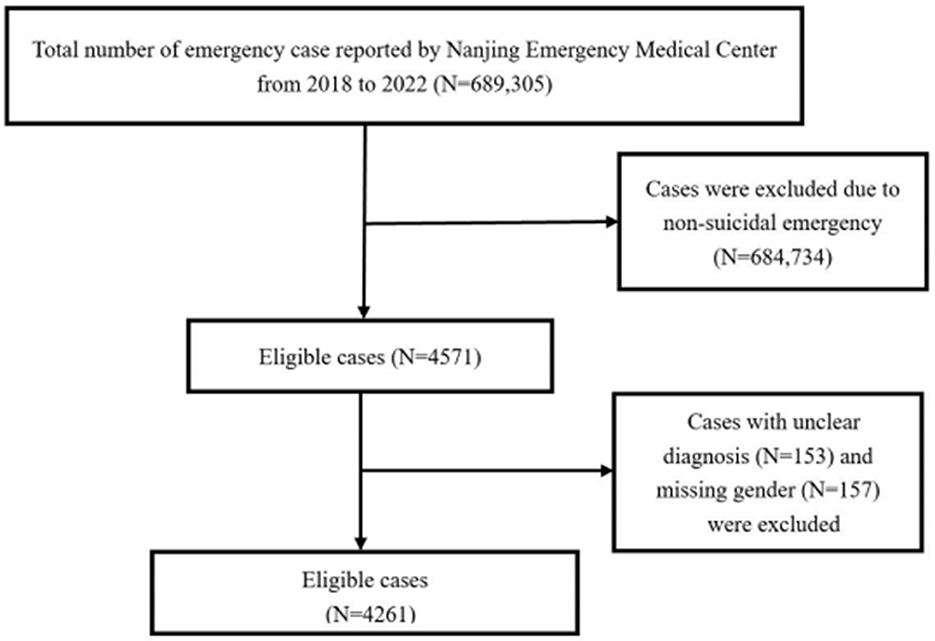
Figure 1. Flow diagram of suicide and self-harm cases screening, 2018–2022.
2.3 Variables and analysisDescriptive statistics were conducted for sex, age, report date, and method of self-harm or suicide. Three authors (R.Y., H.Y., and X.W.) performed a content analysis of self-reported symptoms and primary diagnoses to inductively identify characteristics and precipitating circumstances of self-harm and suicide, grouping them into themes for subgroup analysis. Following the American Medical Association's age designations, the age groups in this study include four sub-groups: Children (1–12 years), Adolescents (13–17 years), Adults (18 years and older), and Older Adults (65 years and older). A constant comparative approach was used to refine themes into more succinct categories (32). Discrepancies in coding were resolved and data saturation was confirmed by reaching a mutual consensus after a discussion between authors (32). Statistical analyses were performed with SPSS, version 26.0 (IBM Corp).
3 ResultTable 1 present a sobering overview of suicide methods based on 4,103 reported events during 2018–2022, revealing concerning trends, particularly in drug poisoning, which accounts for 2,608 events (63.56%). Cutting wrists is the second most common method, with 626 events (15.26%), emphasizing the importance of recognizing self-harming behaviors that can lead to fatal outcomes, while hanging, reported in 509 events (12.41%), remains a notable method despite being less frequent than drug poisoning and wrist cutting. Falling, with 128 events (3.12%), is less common than the top three methods but still significant, whereas drowning, noted in only 41 events (1.00%), and gas poisoning, with 38 events (0.93%), are among the least common methods, indicating they may not be primary focuses for suicide prevention efforts. Additionally, various unspecified methods total 69 events (1.68%), and the use of multiple methods in 84 events (2.05%).
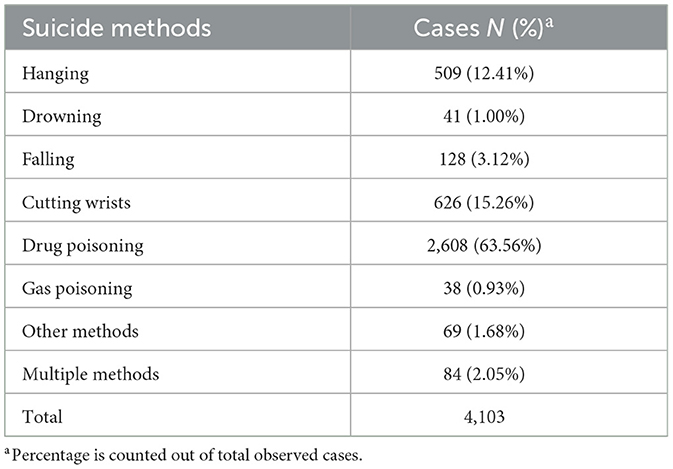
Table 1. Suicide cases reported by Nanjing Emergency Medical Center in Nanjing, Jiangsu, 2018–2022.
During the reporting period, a total of 158 self-harm events were recorded, categorized into four primary methods. Body injury accounted for the highest number of incidents, with 103 events (65.19%), including behaviors like hitting oneself and burning, indicating its prevalence among individuals seeking emergency medical assistance in Nanjing. Other unspecified self-harming behaviors totaled 45 events (28.48%), reflecting a diversity of practices. Cutting wrists was reported in 7 events (4.43%), making it less common, while swallowing foreign bodies was noted in 3 events (1.90%). Overall, the data highlights body injury as the most prevalent form of self-harm, with a significant variety of methods suggesting a need for further exploration and tailored support for those engaging in these behaviors (Table 2).
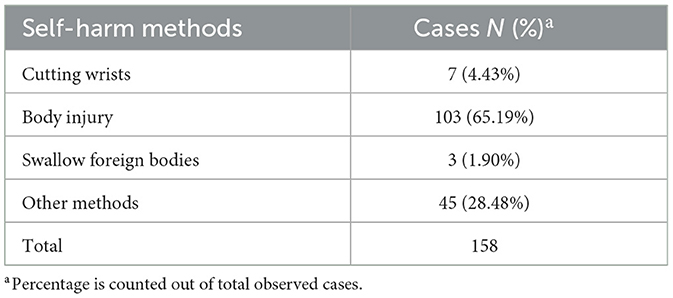
Table 2. Self-harm cases reported by Nanjing Emergency Medical Center in Nanjing, Jiangsu, 2018–2022.
Based on confirmed suicide and self-harm methods in the study, four subgroups were created by different themes, including (1) Years, (2) Seasons, (3) Age, and (4) Gender. For suicide (Table 3 and Figure 2), the age group indicated adult population remained the most reported events compared with youth and older adult populations, and drug poisoning had the largest proportion. In fact, drug poisoning dominated in all three age groups, while hanging shared a similar proportion among the adult and older adult populations rather than that in the youth population. Boundaries of various themes are usually affected due to the complexity associated with interactions between environmental factors and individual characteristics, such as drug poisoning caused most suicide events in all four seasons as same as the trend from 2018 to 2022.

Table 3. Individual characteristics of suicide cases reported by Nanjing Emergency Medical Center in Nanjing, Jiangsu, 2018–2022.
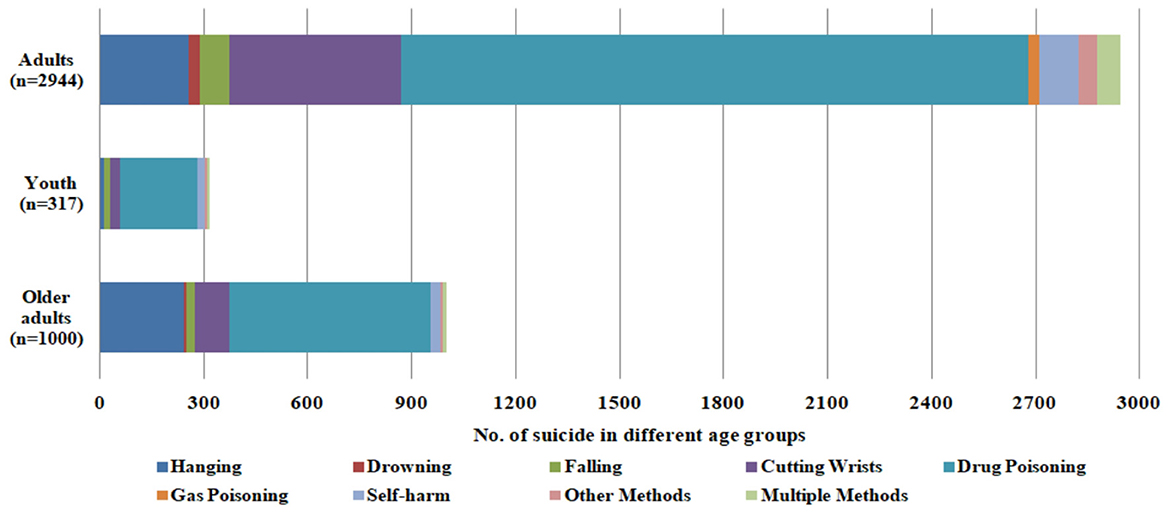
Figure 2. Age group associate with suicide methods of case reported by Nanjing Emergency Medical Center, 2018–2022.
The trends observed in Table 4 and Figure 3 of self-harm incidents in Nanjing from 2018 to 2022 discloses prominent trends. There is a distinct preponderance of self-harm among males over females, suggesting that societal attitudes might influence emotional expression. Seasonal variations indicate higher occurrences in spring and fall, while lower rates are observed in summer and winter, suggesting that environmental factors could play a role. Most self-harm incidents occur among adults, with few among adolescents and none reported among children. These findings emphasize the complexity of self-harm behaviors and the necessity for targeted interventions considering gender, seasonal influences, and age-related factors.
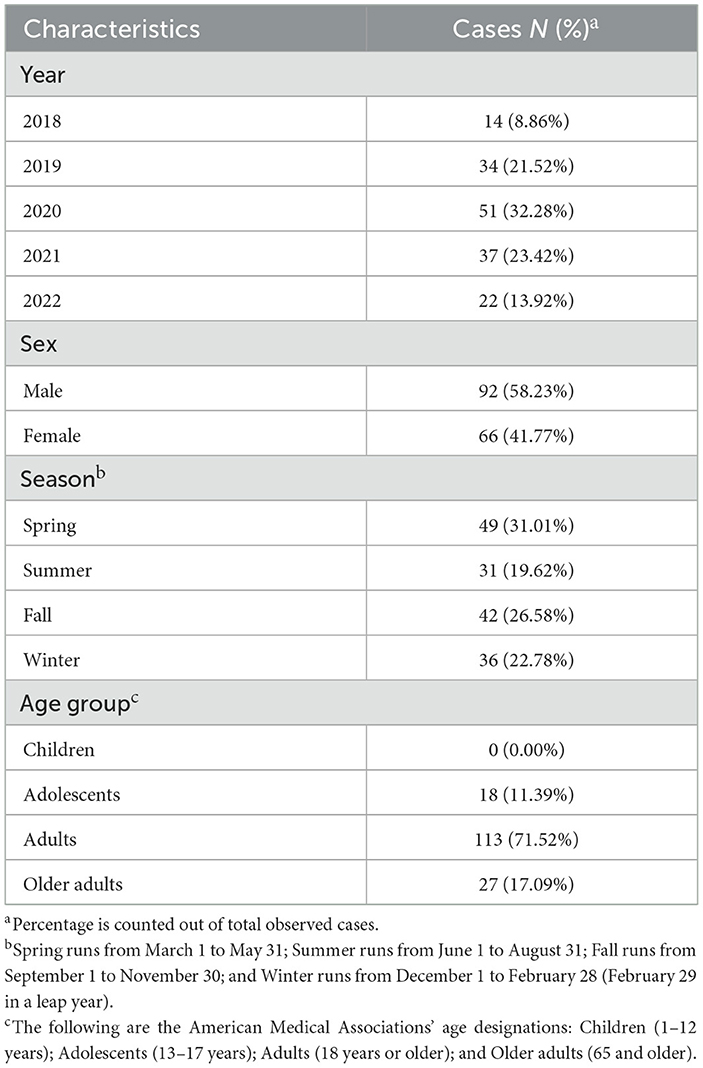
Table 4. Individual characteristics of self-harm cases reported by Nanjing Emergency Medical Center in Nanjing, Jiangsu, 2018–2022.
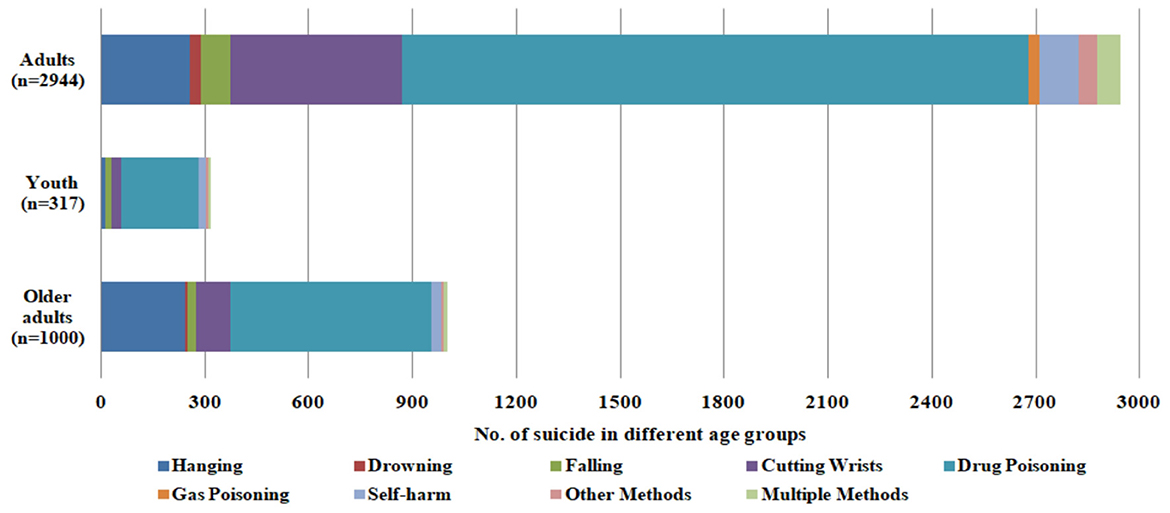
Figure 3. Age group associate with suicide methods of case reported by Nanjing Emergency Medical Center, 2018–2022. The following are the American Medical Associations' age dessignations: youth (1–17 year old); Adults (18 years or olders) and older adults (65 and older).
3.1 YearsTable 5 shows 3,103 reported suicide events, increasing from 374 in 2018 to a peak of 1,101 in 2021, then declining to 776 in 2022. Drug poisoning was the most common method, accounting for 62.03% of events in 2018 and peaking at 66.76% in 2021, before slightly decreasing to 64.56% in 2022. This method consistently represented the majority over the 5 years.
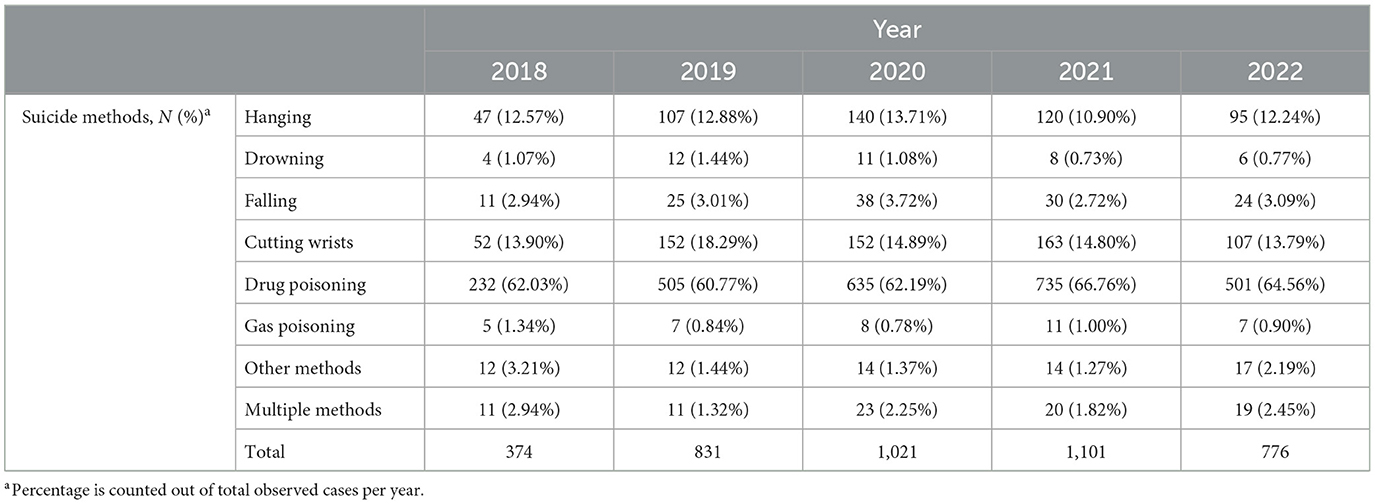
Table 5. Suicide cases reported by Nanjing Emergency Medical Center from 2018 to 2022 in Nanjing, Jiangsu.
Hanging was the second most common method, starting at 12.57% in 2018, peaking at 13.71% in 2020, dropping to 10.90% in 2021, and rising to 12.24% in 2022. Cutting wrists was significant in 2019 and 2020, reaching 18.29% and 14.89%, respectively, but declined to 13.79% by 2022. Other methods, like drowning, falling, gas poisoning, and multiple methods, accounted for smaller percentages, with drowning remaining below 2% each year.
3.2 SeasonsThe highest number occurring in the summer (1,182 events) and the lowest in winter (851 events) (Table 6). The predominant method of suicide across all seasons is drug poisoning, accounting for ~63%−64% of events, with a notable peak in summer (759 events, 64.21%). Cutting wrists is the second most common method, consistently representing around 15% of events in each season, with a slight decrease in winter (134 events, 15.75%). Hanging is also a significant method, particularly in spring (146 events, 13.25%) and summer (152 events, 12.86%), while drowning remains the least common method, with the highest incidence in spring (15 events, 1.36%). Other methods, including falling, gas poisoning, and multiple methods, show varying frequencies, with falling being more prevalent in the fall (39 events, 4.03%).
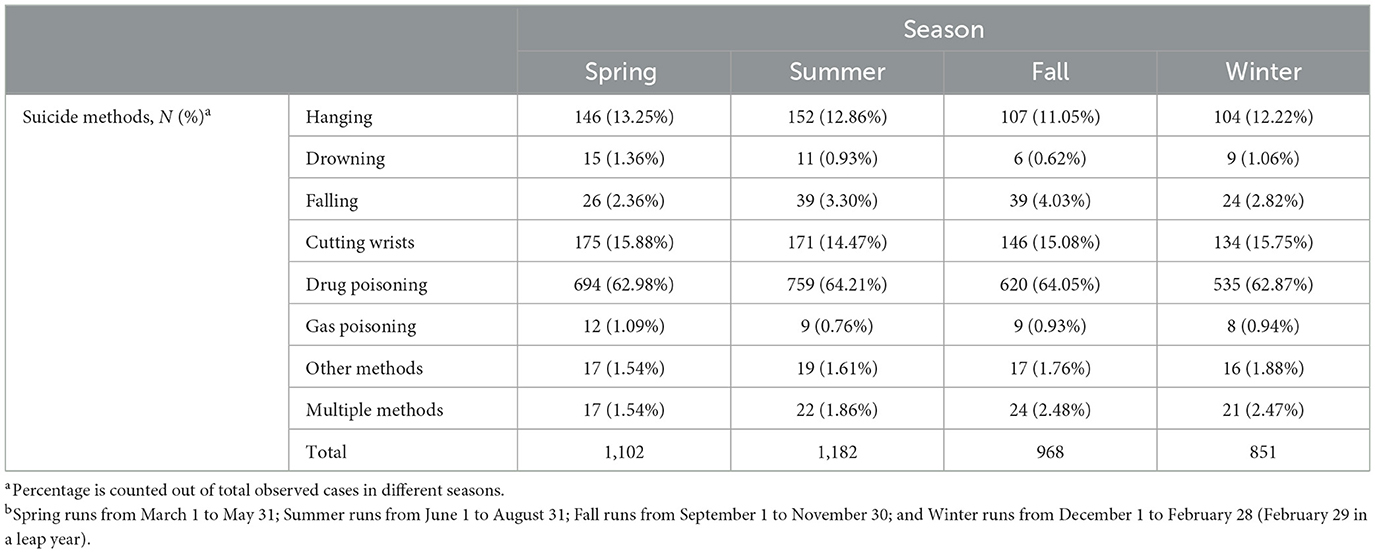
Table 6. Suicide cases in different seasonsb reported by Nanjing Emergency Medical Center, Nanjing, Jiangsu, 2018–2022.
3.3 Age groupsTable 7 presents an analysis of suicide events by age group, as reported by the Nanjing Emergency Medical Center in Jiangsu, China, from 2018 to 2022. The data is divided into four age groups: children, adolescents, adults, and older adults. In total, there were 31 events for children, 268 for adolescents, 2,831 for adults, and 973 for older adults.
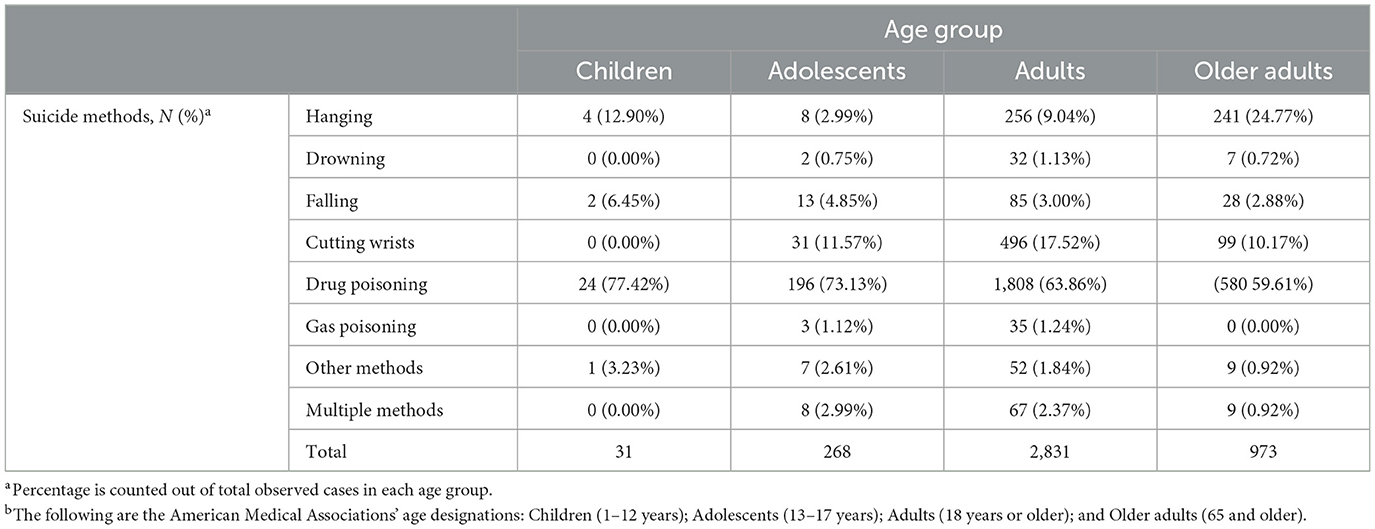
Table 7. Suicide cases of different age groupsb reported by Nanjing Emergency Medical Center in Nanjing, Jiangsu, 2018–2022.
The most common method of suicide across all age groups was drug poisoning, which accounted for a significant percentage of events: 77.42% for children, 73.13% for adolescents, 63.86% for adults, and 59.61% for older adults. This indicates a concerning trend of high drug-related suicides, particularly among younger individuals.
Hanging was the second most common method, especially among adults (9.04%) and older adults (24.77%), but it was less common among children (12.90%) and adolescents (2.99%). Drowning and falling were reported less frequently, with drowning being particularly rare among children (0.00%) and older adults (0.72%). Cutting wrists was notable among adolescents (11.57%) and adults (17.52%), but not among children. The categories of “other methods” and “multiple methods” accounted for a small portion of events in all age groups, with the highest being 3.23% for “other methods” among children and 2.99% for “multiple methods” among adolescents.
3.4 GenderA total of 4,103 suicide events were reported, with 1,547 involving males and 2,556 involving females. The most common method of suicide among males was drug poisoning, accounting for 56.17% (869 events), followed by hanging at 21.01% (325 events) and wrist cutting at 11.12% (172 events). In contrast, females showed a higher prevalence of wrist cutting, which constituted 17.76% (454 events) of their total, while drug poisoning was also significant at 68.04% (1,739 events).
Other methods included hanging, drowning, and gas poisoning. Males had a higher percentage of hanging incidents (21.01%) compared to females (7.20%). Drowning was relatively uncommon, with males at 1.36% (21 events) and females at 0.78% (20 events). Falling incidents were slightly more frequent among males (4.20%) than females (2.46%). Gas poisoning was infrequent, with males at 1.55% (24 events) and females at 0.55% (14 events) (Table 8).
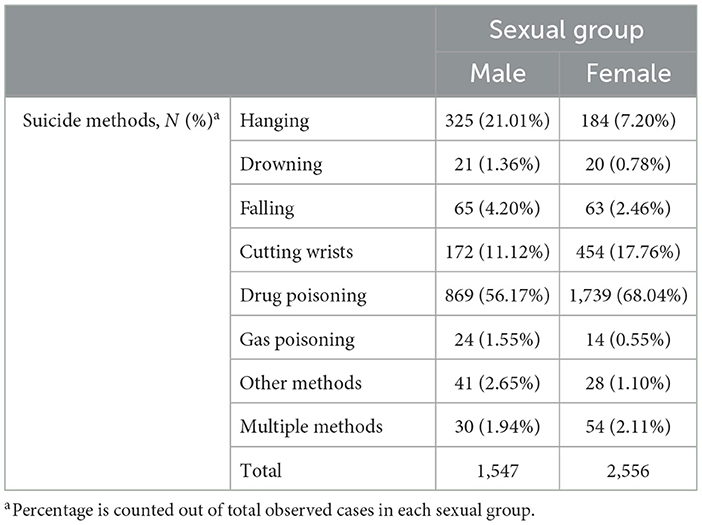
Table 8. Suicide cases of sexual group reported by Nanjing Emergency Medical Center in Nanjing, Jiangsu, 2018–2022.
3.5 Classification of drug poisoningIn this study, we focused significantly on drug poisoning as the leading method of suicide among the sample population, classifying drug types based on the chief complaints of patients or descriptions provided by those who called for emergency assistance (Table 9). A total of 1,197 cases (44.97%) involved overdoses of psychotropic medications, including sleeping pills, antidepressants, and the sedative lorazepam. Additionally, overdoses of other drugs, such as cold medications, hypotensive drugs, and specific medications for other conditions, accounted for 31.56% of cases. For example, one case involved an 85-year-old female who “took valsartan 80 mg, ~40 capsules over more than 2 h,” while another case involved a 29-year-old male who “drank toilet cleaner for 40 min.” Notably, suicides involving pesticides accounted for 21.30%, placing them in third position, followed by rat poison (2.07%) and opioids (0.11%).
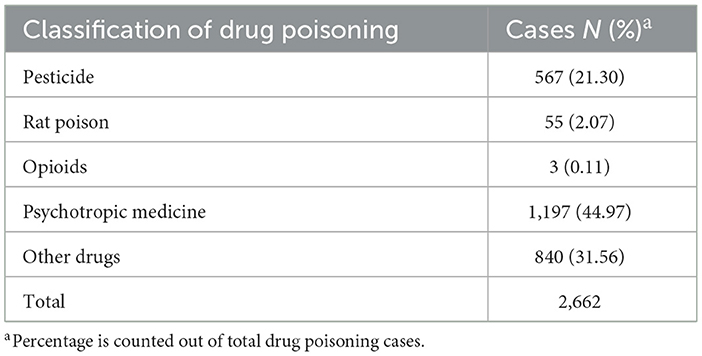
Table 9. Classification of drug poisoning in reported suicide cases.
4 DiscussionThis descriptive study examined ambulance records from the NEMC between 2018 and 2022, focusing on suicide and self-harm events. Out of 689,305 calls, 4,261 cases related to self-harm or suicide were analyzed. The study found that drug poisoning was the most prevalent method of suicide, accounting for 63.56% of cases, followed by wrist cutting (15.26%) and hanging (12.41%). Self-harm incidents primarily involved body injuries (65.19%). The analysis revealed significant trends across age groups, seasons, and gender, with higher rates among adults and males. Drug poisoning was notably common across all age groups, particularly among younger individuals.
Our study revealed that both men and adults were the two main groups that endured higher burdens of self-harm compared to others. Although the national circumstances in China indicated that females used to be in disadvantaged positions and had greater burdens of self-harm than males (33). Nevertheless, our findings indicated that females witnessed a greater reduction in the burden of self-harm than males from 2018 to 2022 in Nanjing, which was consistent with the national results in China (14, 34, 35). Some researches attributed the big declining trends among females to the process of urbanization and economic development during the past decades (36). Meanwhile, in the current social changes in China, intense work stress and anxiety caused by the rapid increase in the cost of living may exert more pressure on males. These factors are not beneficial to their mental health and make them prone to mental illness, a key risk factor for self-harm (37).
According to previous research, although suicide has been a challenging public health problem in China, (38) with the rising economic levels and great social changes, a dramatic decline in Chinese suicide rates has been observed in the last three decades (16, 39, 40). Our study reported that the previously declining trend in suicides has recently reversed in Nanjing. To the best of our knowledge, these findings are consistent with a recent study of a large nationwide sample in China (2), which indicated a relatively high prevalence of suicidal idealization among the general population during the COVID-19 pandemic. The outbreak of the pandemic has had profound health, psychological, social, and economic consequences worldwide, which may have heightened various suicide risk factors (41, 42). Nevertheless, the number of suicide cases observed in 2022 has reduced to a similar level in 2019. This indicates that as the pandemic evolves, the suicide situation might be changing, so it is necessary to have ongoing monitoring and real-time surveillance (43).
Our study revealed that the seasonal peak of suicidal behaviors was typically witnessed in summer and hit the bottom in winter. A previous study examined the influence of social and bio-climatic factors by using 28 countries time series data, reported that populations in the temperature zone exhibited suicide seasonality (44). The climate in the temperate zone always showed the widest seasonal change with the longest day length in spring time/early summer which may introduce a potential influence from a geographic perspective toward the seasonal cycle of suicides (45). The activity of serotonin that regulated the mood and impulse control of human beings were sensitive to climate change and a marked seasonal fluctuation was reported (46). It was noted that the malfunctioning of one's serotonin could be one of the most imperative factors that drive a person to have a deliberate self-harm behavior (47, 48). The inter-correlation among climate change, serotonin function, and suicidal ideation may help explain the seasonal effect on suicides, as studies show a strong link between climatic factors, especially sunshine exposure, and suicidal behavior (45, 49, 50).
However, this might not hold true for those countries situated in the tropical zone where the climate exhibits no distinct seasons. No seasonal pattern was discerned in suicide deaths in Colombia, a country located in the inter-tropical zone with stable temperatures throughout the year (51). A similar finding was reported in the city of Sao Paulo which is a municipality in the southeast region of Brazil (52) and in Singapore, one of the Asian countries lying one degree north of the equator (53). A study by Cantor et al. (54) examined the Caucasian population near the equator in Australia. It found that male suicides peaked in spring and early summer, while female suicides were at their lowest in autumn. Although some variations were noted, climate factors appeared to have less influence in the tropical zone.
These findings highlight a clear seasonal pattern in suicidal behaviors, which should impact existing public health measures mentioned previously. For instance, it may be beneficial to reinforce connections with patients who have a history of suicide attempts or suicidal thoughts during the summer through brief contact interventions (55, 56). In addition, broad public health campaigns for prevention and awareness should be implemented during at-risk periods. Practitioners should also be more vigilant in the spring and summer for patients at risk of suicide, including those with suicidal ideation, a history of suicidal behaviors, or psychiatric disorders (57). Nevertheless, further studies are needed to better understand the physiological mechanisms underlying the meteorological factors that impact suicidal behaviors (57).
The increase in suicide cases seen in this study is mainly due to rising rates among young and older adults. In China, suicide is the leading cause of death for people aged 15–34, significantly adding to the overall health burden (58). Moreover, stress-diathesis models suggest that stressful life events interact with vulnerability factors, increasing the likelihood of suicidal behavior (59). Adolescence can be a vulnerable time for dealing with life stressors like family conflicts and academic pressure (60). Previous studies found that many university students do not value life enough and have a weak sense of survival, which may indicate a lack of social support and hope among young people (61). In fact, studies found that depressive symptoms had direct and indirect effects on suicide risk among young adults (62, 63), however, these correlations were weak (61). Thus, many young people at risk of suicide may not have mood disorder while the risk come from not valuing life, having poor problem-solving skills, and other reasons, like believing that suicide is a way to express or defend their faith (61). Regarding young adults in Nanjing, concern about economic problems is a common trigger for suicide among this age group (64), Many young adults play the role of breadwinners for their families and consequently experience more economic stress than people in other age groups (18).
On the other hand, China is experiencing a rapidly aging population as the first wave of baby boomers born in the 1950s and 1960s began turning 60 in the 2010s (65). Rapid macro-socio-economic changes and urbanization may lead to disconnection, physical alienation, loss of normal social interactions, and increased anxiety or depression among the older population in Nanjing (66, 67). Moreover, suicidal behavior is associated with chronic diseases which were significant in older population (68). The modernization of a society leads to dramatic social changes that without doubt would affect older people (46). A higher life expectancy leads to a larger proportion of older adult people in the population, raising concerns about resource competition. Research suggests that a well-developed social welfare system for the older adult is a key protective factor against suicide among older adults. Enhancing social activities for this group may foster connections and reduce the seasonal effects related to their means of staying in touch. A better social welfare system, along with proactive engagement with older adults, could significantly improve the current situation (46).
Regarding gender, previous studies have indicated that females have higher suicidal ideation than males (69, 70), which is consistent with our findings as well. Although one of studies from South Korea have not reached a definite conclusion (71), additional has proved that female with low socio-economic status have a significantly higher number of suicide attempts, especially those who are receiving national basic livelihood security (OR: 1.820) (72). However, more studies have found that female suicide is related to increased economic stress, unemployment, and income loss (73, 74). Specifically, lifetime incarceration, previous trauma, and earning < $40,000 emerged as a greater risk for suicide attempts in women (75). Data reported by the WHO in 2012 align with our study results, indicating that female students in China had higher suicide rates (61). Therefore, it is important to further explore how gender differences affect suicide risk.
Lastly, ingesting pesticides was once the most common method of suicide in China, accounting for 58% of all suicides between 1996 and 2000 (76). However, after strict laws were implemented on the use of lethal pesticides in agriculture, the rate of pesticide-related suicides declined rapidly (77). Today, drug poisoning, especially the misuse of mental health and sedative drugs, has emerged as the most common means of suicide in Nanjing. This suggests that suicide prevention strategies should be updated (3). In one respect, the increase in depression diagnoses among suicide victims indicates that more attention should be paid to the treatment of depression (3). For instance, China's primary mental health care system is hospital-centered and needs improvement to better cover high-risk populations (78), and the government should enhance the regulation of psychotropic drugs through both policy and legal means.
A key advantage of this study lies in the fact that we employed suicide data from the NEMC, which covers all emergency calls in Nanjing. Such data is highly representative and avoids the risk of sampling errors. However, this study also has some limitations. First, it was a cross-sectional study, and the causal relationship between multiple risk factors could not be determined (2). Second, suicide is a sensitive subject in China, which implies that additional demographic details, such as educational level, employment status, and medical complications, are frequently not accessible. Therefore, without understanding the main factors that lead to suicide attempts, we cannot effectively target prevention efforts (79). The suicide cases in our study did not include regional information about where the suicides occurred, which may underestimate the number of cases, particularly in rural areas, and makes analysis more difficult.
5 ConclusionIn summary, the number of self-harm and suicide cases among ambulance medical emergencies in Nanjing, China, rose from 2018 to 2021 but declined in 2022. Females, as well as young and older adults, were particularly impacted, with incidents happening most frequently in summer. Drug poisoning was the most prevalent method of suicide. These findings enhance our comprehension of self-harm and suicide trends, assisting in identifying at-risk populations and informing targeted prevention strategies. Additionally, future research should incorporate longitudinal studies that broaden the measurement of self-harm and suicide behaviors and systematically evaluate long-term outcomes.
Data availability statementThe raw data supporting the conclusions of this article will be made available after notifying corresponding author via email. Requests to access the datasets should be directed to Xu Wang, c2VwbmluZUBuam11LmVkdS5jbg==.
Ethics statementThe studies involving humans were approved by the Medical Ethics Committee of the Children's Hospital of Nanjing Medical University. The studies were conducted in accordance with the local legislation and institutional requirements. The ethics committee/institutional review board waived the requirement of written informed consent for participation from the participants or the participants' legal guardians/next of kin because the need for consent to participate was deemed unnecessary and waived by IEC of Children's Hospital of Nanjing Medical University (approval numb 202309012-1) because our study was conducted using medical records or biological samples obtained from previous clinical treatments.
Author contributionsRY: Data curation, Formal analysis, Investigation, Writing – original draft. JZ: Investigation, Methodology, Supervision, Writing – original draft. FB: Supervision, Validation, Visualization, Writing – review & editing. WY: Resources, Software, Writing – review & editing. XW: Formal analysis, Investigation, Methodology, Project administration, Writing – review & editing. HY: Data curation, Investigation, Software, Writing – original draft, Writing – review & editing.
FundingThe author(s) declare that no financial support was received for the research, authorship, and/or publication of this article.
Conflict of interestThe authors declare that the research was conducted in the absence of any commercial or financial relationships that could be construed as a potential conflict of interest.
Publisher's noteAll claims expressed in this article are solely those of the authors and do not necessarily represent those of their affiliated organizations, or those of the publisher, the editors and the reviewers. Any product that may be evaluated in this article, or claim that may be made by its manufacturer, is not guaranteed or endorsed by the publisher.
References1. Rogers JP, Chesney E, Oliver D, Begum N, Saini A, Wang S, et al. Suicide, self-harm and thoughts of suicide or self-harm in infectious disease epidemics: a systematic review and meta-analysis. Epidemiol Psychiatr Sci. (2021) 30:e32. doi: 10.1017/S2045796021000354
Crossref Full Text | Google Scholar
2. Shi L, Que J-Y, Lu Z-A, Gong Y-M, Liu L, Wang Y-H, et al. Prevalence and correlates of suicidal ideation among the general population in China during the COVID-19 pandemic. Eur Psychiatry. (2021) 64:e18. doi: 10.1192/j.eurpsy.2021.5
PubMed Abstract | Crossref Full Text | Google Scholar
3. Qiao J, Xia T, Fang B, Cai R, Chen L, Qian N, et al. The reversing trend in suicide rates in Shanghai, China, from 2002 to 2020. J Affect Disord. (2022) 308:147–154. doi: 10.1016/j.jad.2022.04.056
PubMed Abstract | Crossref Full Text | Google Scholar
4. Stone DM, Simon TR, Fowler KA, Kegler SR, Yuan K, Holland KM, et al. Vital signs: trends in state suicide rates—United States, 1999-2016 and circumstances contributing to suicide-−27 States, 2015. MMWR Morb Mortal Wkly Rep. (2018) 67:617–624. doi: 10.15585/mmwr.mm6722a1
PubMed Abstract | Crossref Full Text | Google Scholar
8. Suominen K, Isometsä E, Suokas J, Haukka J, Achte K, Lönnqvist J. Completed suicide after a suicide attempt: a 37-year follow-up study. Am J Psychiatry. (2004) 161:562–3. doi: 10.1176/appi.ajp.161.3.562
PubMed Abstract | Crossref Full Text | Google Scholar
9. Cooper J, Kapur N, Webb R, Lawlor M, Guthrie E, Mackway-Jones K. Suicide after deliberate self-harm: a 4-year cohort study. Am J Psychiatry. (2005) 162:297–303. doi: 10.1176/appi.ajp.162.2.297
PubMed Abstract | Crossref Full Text | Google Scholar
10. Zahl DL, Hawton K. Repetition of deliberate self-harm and subsequent suicide risk: long-term follow-up study of 11,583 patients. Br J Psychiatry. (2004) 185:70–5. doi: 10.1192/bjp.185.1.70
PubMed Abstract | Crossref Full Text | Google Scholar
11. Zou Y, Leung R, Lin S, Yang M, Lu T, Li X, et al. Attitudes towards suicide in urban and rural China: a population based, cross-sectional study. BMC Psychiatry. (2016) 16:162. doi: 10.1186/s12888-016-0872-z
PubMed Abstract | Crossref Full Text | Google Scholar
12. Yip PSF, Zheng Y, Wong C. Demographic and epidemiological decomposition analysis of global changes in suicide rates and numbers over the period 1990-2019. Inj Prev. (2022) 28:117-124. doi: 10.1136/injuryprev-2021-044263
PubMed Abstract | Crossref Full Text | Google Scholar
13. Sha F, Chang Q, Law YW, Hong Q, Yip PSF. Suicide rates in China, 2004-2014: comparing data from two sample-based mortality surveillance systems. BMC Public Health. (2018) 18:239. doi: 10.1186/s12889-018-5161-y
PubMed Abstract | Crossref Full Text | Google Scholar
16. Yip PSF, Liu KY, Hu J, Song XM. Suicide rates in China during a decade of rapid social changes. Soc Psychiatry Psychiatr Epidemiol. (2005) 40:792–8. doi: 10.1007/s00127-005-0952-8
PubMed Abstract | Crossref Full Text | Google Scholar
17. Zhou X, Li R, Cheng P, Wang X, Gao Q, Zhu H. Global burden of self-harm and interpersonal violence and influencing factors study 1990–2019: analysis of the global burden of disease study. BMC Public Health. (2024) 24:1035. doi: 10.1186/s12889-024-18151-3
PubMed Abstract | Crossref Full Text | Google Scholar
18. Cai Z, Chen M, Ye P, Yip PSF. Socio-economic determinants of suicide rates in transforming China: A spatial-temporal analysis from 1990 to 2015. Lancet Reg Health West Pac. (2022) 19:100341. doi: 10.1016/j.lanwpc.2021.100341
留言 (0)